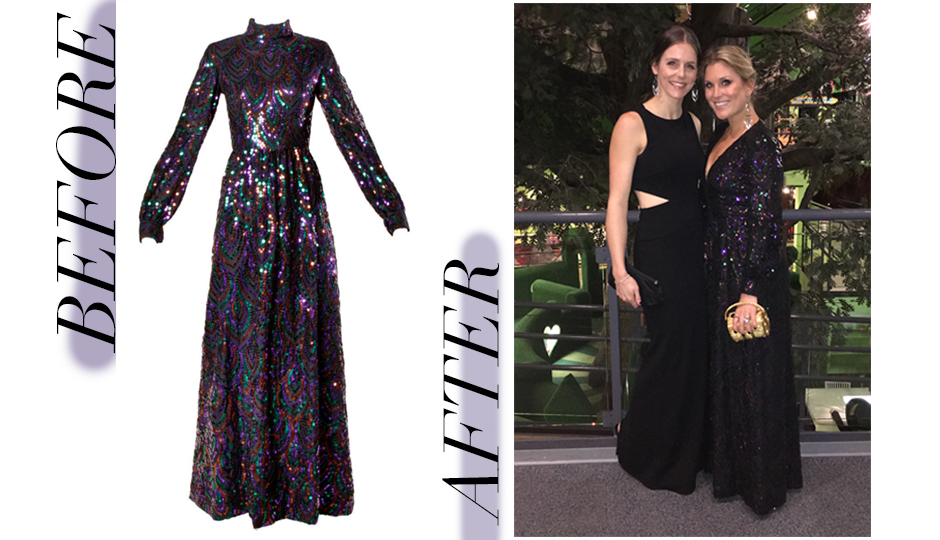Evolution of a Dress: How I Took a 1970s Gown and Altered It to Modern Perfection

The first cut is the deepest: A before-and-after of the dress. | Images via The Tailory.
When the EIC of Philadephia Wedding announced she was having a black-tie New Year’s Eve wedding, our close-knit group of work friends immediately convened for a what-to-wear powwow. Two women declared they’d try Rent the Runway; another decided to beeline it to New York for a shopping trip; and I considered wearing something already in my closet. (I have a bad habit of buying extremely fancy things like ball skirts and floor-length dresses with no place to wear them.) This was a fleeting idea, though: After a quick survey of my wardrobe, I found that nothing checked off both black-tie and New Year’s Eve boxes. The search was on.
I had a vague idea of what I wanted to wear – something floor-length and long-sleeved – and a nebulous design idea that looked achingly similar to this dress. A providential search on 1stdibs, one of my favorite online haunts for antique and vintage goods, led me to a 1970s Jeremy Wren gown. I hesitated at first: Buying vintage, especially online, is a bit of a gamble. Sizing can be tricky; condition debatable. But the dress – a long-sleeved column of copper, green and purple sequins – was too good to pass up. So I took some hasty and probably very incorrect measurements (a 26-inch waist? Sure!), clicked ‘buy,’ and then promptly emailed Sara Teixeira, owner of The Tailory, an alterations and tailoring studio in Old City, to set up an appointment. Among a smattering of smiley faces and exclamation points, I admitted that the dress might be the wrong size, and was potentially horrible-looking in person, and maybe needed a total revamp. She responded two days later: Bring it in! Game. On.
The dress arrived at my office a week later and was, as far as online vintage shopping goes, a miracle. First, it fit. Perfectly. And it was gorgeous, with its high neck, structured shoulders, buttoned cuffs, and swirling petals of sequins. I was torn: I’d initially bought it expecting to hack off the high neck and wear it as a deep V, but it looked pretty fantastic as it was. I wore it around the office and took a vote, which ended up not being helpful, as we arrived at a split decision. It became an office debate: High neck or deep V? One of our art directors Photoshopped a deeply exposed clavicle onto a picture of me in the dress, which was at once extremely creepy and weirdly helpful.
I took the dress and the creepy Photoshopped picture to Sara’s Vine Street studio one night. We looked at the dress, heads cocked, for a long time. She studied the construction to see if the deep V could even be done, using tacking tape to outline where it would be, how deep it could go, what it might look like. The shoulders would need to be reconstructed to hold the weight of the dress, and the sequin pattern would need to be matched up perfectly. It would be difficult, she said, but it was doable. After very dramatic fretting, I decided to go for it.
After one fitting and three weeks, Sara was finished. The end result was fantastic. The dress was still distinctly vintage, but with a slightly more modern edge that helped keep it from veering into costume territory. It was easier to move in, too, and the long sleeves and sharp shoulders (Sara constructed new shoulder pads to help carry the weight of the dress) balanced out the sexiness of the new neckline. But making a major design change to a vintage garment shouldn’t be taken lightly. You have to consider the structure and original design of the item. Take it to a professional who can give you an honest opinion, and make sure they have experience working with older pieces, which generally require more care and a gentler touch. Be sure to consider all options before making a decision; sometimes different isn’t better and some wheels don’t need to be reinvented. But sometimes, as I’ve learned, you just need to take the plunge.

(left) The dress as featured on 1stdibs. (right) The finished product, with a bonus appearance by Be Well Philly editor Emily Leaman.
The Details: The Tailory, 217 Vine Street, Old City, 484-483-6677.
